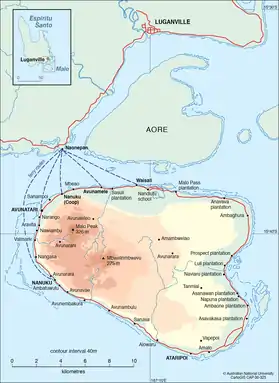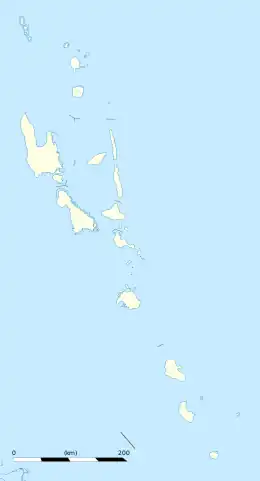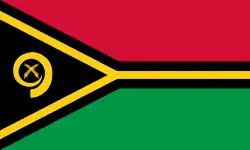Malo (island)
Malo (formerly known as St. Bartholomew) is an island in Vanuatu 3 km (1.9 mi) off the southern coast of Vanuatu's largest island, Espiritu Santo, in Sanma Province.[1][2] It has a circumference of 55 km (34 mi) and an area of 180 km2 (69 sq mi). It is 17 kilometres or 11 miles long, and 13 kilometres or 8.1 miles wide. The highest point on the island is Mount Malo (326 metres or 1,070 feet).
Tamambo | |
|---|---|
 Map of the island | |
 Malo | |
| Geography | |
| Location | Pacific Ocean |
| Coordinates | 15°41′S 167°10′E |
| Archipelago | New Hebrides |
| Area | 180 km2 (69 sq mi) |
| Highest elevation | 326 m (1070 ft) |
| Administration | |
Vanuatu | |
| Province | Sanma |
| Demographics | |
| Population | 4,273 (2009) |
| Ethnic groups | Ni-Vanuatu |
The climate is perhumid tropical. The average annual amount of rainfall is roughly 3,000 millimetres or 120 inches. The island is frequently subjected to cyclones and earthquakes.
Geography
Like most of the islands of Vanuatu, Malo is of volcanic origin. The highest point on the island is Malo Peak, which rises to 326 m (1,070 ft) above sea level.[3]
The main products of the island are copra and cocoa. Both crops are grown on plantations.[2]
Natural history
A 5,650 hectares or 13,960 acres tract, encompassing the western end of the island, has been recognised as an Important Bird Area (IBA) by BirdLife International, because it supports populations of Vanuatu megapodes, Vanuatu kingfishers, palm lorikeets, fan-tailed gerygones, and Vanuatu white-eyes.[4]
The pseudohermaphroditic Narave pig is found on the island. The pig considered to be sacred by the people of Malo Island.[5][6][7]
Demographics
In 1979, the island had a population of 2,312. The 1999 census found a population of 3,532. By the 2009 census, the total population had grown to 4,273, an increase of 21% since 1999.[8] Avunatari (Abnetare), the main center on the northwest coast, had 600 people in 1999.
There are two main cultural groups on the island of Malo, the cultural group of Auta that inhabits the western part of the island as well as the cultural group of Tinjivo that inhabits the eastern portion of the island. Both these cultural group speak a variant of the Tamambo language. Malo is also the name of the Austronesian language spoken on the island.
The earliest archaeological evidence of human habitation in Vanuatu is from a site on Malo that was settled circa 1400 BC. Artifacts from this early settlement are characteristic of the Lapita culture.[2][9]
References
- "Surrounding Islands". Espiritu Santo Tourism. Retrieved 17 August 2018.
- John Seach. "Malo Island, Vanuatu". Vanuatu Travel. Retrieved 2012-02-18.
- Siméoni, Patricia (2009). Atlas du Vanouatou. Port-Vila: Éditions Géo-consultre. p. 31. ISBN 978-2-9533362-0-7.
- "West Malo". BirdLife Data Zone. BirdLife International. 2021. Retrieved 12 February 2021.
- "Intersex Pigs". Southwest Pacific Research Project. Retrieved 2023-03-07.
- "Pigs in Paradise". Penn State University. Retrieved 2023-03-07.
- Lum, J. Koji; McIntyre, James K.; Greger, Douglas L.; Huffman, Kirk W.; Vilar, Miguel G. (November 14, 2006). "Recent Southeast Asian domestication and Lapita dispersal of sacred male pseudohermaphroditic "tuskers" and hairless pigs of Vanuatu". Proceedings of the National Academy of Sciences. 103 (46): 17190–17195. doi:10.1073/pnas.0608220103. PMC 1859908. PMID 17088556.
- 2009 National Census of Population and Housing Summary Release, Port Vila, Vanuatu: Vanuatu National Statistics Office, 31 August 2009, retrieved 23 February 2012
-
Michelle Bennett; Jocelyn Harewood (September 2003). Vanuatu. Lonely Planet. p. 11. ISBN 978-1-74059-239-0. Retrieved 2012-08-11.
The earliest evidence of human occupation in Vanuatu comes from a site on the island of Malo, first settled in about 1400 BC by people of the Lapita culture.
